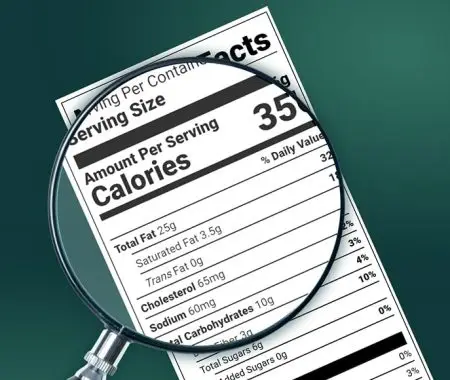When it comes to navigating the aisles of your local supermarket, the information on food labels is vital. Among the most pivotal pieces of this nutritional puzzle is the serving size. Serving size indicates how much people eat in one sitting and is found under the Nutrition Facts section of a food label. It is listed as “Per (specified the serving size)”, “Serving Size (specified the serving size)”, or “Serving (specified the serving size)”. It is not just a number but serves as a guide to shape our understanding of what we consume.
Recognizing this, the Canadian Food Inspection Agency (CFIA) has recently fine-tuned its serving size regulations. This is a response to evolving dietary habits and ensures that when you glance at a label, what you see reflects your real-life portions.
TLDR
- Health Canada updated serving size regulations in 2022 to make food labels more reflective of actual consumption habits, aiding consumers in making healthier choices.
- Serving sizes on labels now match the typical amount consumed in one sitting, facilitating easier comparison of similar products.
- New reference amounts guide the serving sizes on Nutrition Facts tables, based on updated data on how much food is typically consumed at once.
- Packages meant to be consumed in one sitting are labeled as single servings.
- Packages not meeting single-serving criteria are considered multiple servings. However, items like large cookies, typically consumed in one sitting, can still be labeled as a single serving.
- Some products now feature a dual-column Nutrition Facts table to show nutritional information per serving and per container, clarifying total intake if the entire package is consumed.
- The food and beverage industry must adapt to these changes by updating labeling practices to ensure transparency and compliance.
- Platforms like Food Label Maker are essential for adapting to new regulations, offering a streamlined solution for label updates to meet CFIA standards and consumer needs.
- The update marks a significant shift from arbitrary serving sizes to standardized amounts based on actual consumption, making nutritional information more accessible and comparable.
Understanding the New Serving Size Regulations
The new serving size regulations implemented on Canadian food labels are part of Health Canada’s efforts to make nutritional information more intuitive and reflective of actual consumption habits. These changes were first introduced on November 24, 2022, and aim to standardize serving sizes across similar products to help consumers compare nutritional information easily and make healthier food choices.
Key aspects of the new regulations include:
- Standardization of Serving Sizes: Serving sizes must now reflect the amount of food typically consumed in one sitting. This makes it easier for consumers to compare the nutritional content of similar items.
- Reference Amounts: The regulations have introduced updated reference amounts, which are used to determine the serving size listed on the Nutrition Facts table. These reference amounts are based on the quantity of food typically eaten at one time and have been updated to reflect current consumption data.
- Single-Serve Containers: Single-serve containers are designed for products that are usually eaten or drunk in one sitting. So, the entire content of such a package counts as one serving. This rule applies to things like a bottle of soda or a small bag of chips, where the nutritional information on the label matches what you’d consume if you finished the whole thing. A package is considered single-serve if it holds up to twice (200%) the standard serving size, known as the “reference amount,” set by guidelines. For instance, if the reference amount for chocolate milk is 250 mL, but the bottle contains 473 mL, it still counts as a single serving because it’s less than twice the reference amount (which would be 500 mL). This makes it easier to understand how much you’re consuming in one go, especially for items typically consumed all at once.
- Multiple-serving package: If the package doesn’t fit the single-serving rules, it is considered as multiple servings. This means you’re expected to eat it in more than one sitting or share it. Let’s say there’s a big cookie that’s 100 g, but the standard serving size for cookies is 30 g. Normally, this would be more than one serving. But if it’s the kind of cookie that people usually eat all at once, it can still be considered a single serving.
- Dual Column Format: Some products that could be consumed in one sitting or multiple sittings now require a dual-column Nutrition Facts table. This format shows nutritional information per serving and per container, providing a clearer picture of the total nutritional content if the entire package is consumed. For example, a small bag of chips that might be eaten in one sitting or shared will have a label showing the calories, fat, sodium, etc., per serving (such as per 10 chips) and per entire bag (if the bag contains, say, 30 chips).
What this means for food product labeling is that businesses need to recalibrate. This isn’t just about tweaking numbers; it’s about reevaluating how products are consumed and ensuring that labels mirror these patterns. It’s also a shift that demands attention to detail and an understanding of consumer behavior. For those in the food industry, it’s about redesigning and realigning product labels to uphold transparency and foster informed dietary choices.
See How FoodLabelMaker Can Help You
Comparison: Old vs. New Serving Size Regulations
| Feature | Old Regulations | New Regulations |
| Serving Size Basis | Based on a variety of factors and not always reflecting typical consumption habits. | Standardized based on the amount of food typically consumed in one sitting, making it easier to compare similar foods. |
| Reference Amounts | Less consistent across similar products. | Updated to reflect current consumption patterns, providing consistency across similar types of foods. |
| Single-Serve Containers | Serving size might not reflect the entire content for single-consumption items. | The entire content of single-serve packages is considered as one serving, aligning with typical consumption. |
| Dual Column Format | Not commonly used. | Required for certain products, showing nutritional information per serving and per package for clarity. |
| Comparison | Comparing nutritional information between products could be challenging. | Easier to compare nutritional information directly between similar products due to standardized serving sizes. |
The leap from old to new serving size regulations marks a significant shift in how food information is presented to Canadian consumers. Previously, serving sizes could be somewhat arbitrary, not always reflecting the quantities people typically consume in one sitting. This often led to confusion, with consumers struggling to reconcile the serving sizes listed on labels with their actual eating habits. The new regulations standardize serving sizes across similar products and align them more closely with realistic consumption patterns.
Implications for B2B Enterprises
For B2B enterprises in the Food and Beverage industry, these regulatory updates represent a shift in how products must be presented to the market. Adapting to these changes requires an understanding of consumer behavior and a readiness to update labeling practices. Compliance is also about avoiding legal penalties and ensuring that your product information is transparent, accurate, and user-friendly. This means revisiting your product portfolio, analyzing consumption patterns, and possibly reevaluating package sizes to align with the new serving size guidelines.
Platforms like Food Label Maker have become invaluable when dealing with these changes. They offer a streamlined, reliable solution for adapting to the new serving size regulations and assure that your products not only meet CFIA standards but also resonate with the values and needs of your consumers. Food Label Maker ensures that these updates follow regulatory compliance and empower Canadians to make healthier, more informed food choices every day.
Leveraging Software for Compliance
In this era of regulatory evolution, software solutions like Food Label Maker emerge as powerful allies for businesses striving to stay compliant. These tools are designed with the complexities of CFIA regulations in mind, offering features that simplify the process of updating labels to meet the new serving size standards.
With Food Label Maker, businesses can automate much of the label adjustment process, ensuring accuracy and consistency across product lines. The benefits of using such software are that compliance standards are met and it saves time and resources by reducing the risk of human error. This ultimately fortifies your brand’s reputation for reliability and consumer-centricity. In a marketplace that values transparency and informed choices, having the right tools at your disposal isn’t just an advantage – it’s a necessity.



